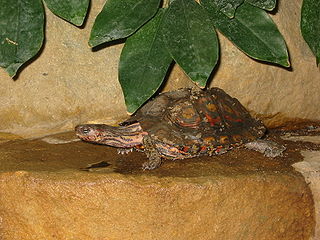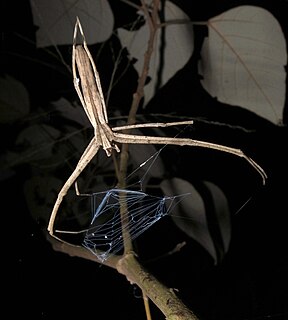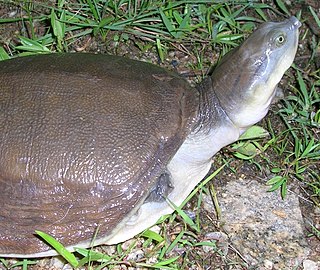
Pangolins or scaly anteaters are mammals of the order Pholidota. The one extant family, Manidae, has three genera: Manis, which comprises four species living in Asia; Phataginus, which comprises two species living in Africa; and Smutsia, which comprises two species also living in Africa. These species range in size from 30 to 100 cm. A number of extinct pangolin species are also known.

Albert Namatjira, born Elea Namatjira, was a Western Arrernte-speaking Aboriginal artist from the MacDonnell Ranges in Central Australia. As a pioneer of contemporary Indigenous Australian art, he was the most famous Indigenous Australian of his generation.

The Geoemydidae are one of the largest and most diverse families in the order Testudines (turtles), with about 70 species. The family includes the Eurasian pond and river turtles and Neotropical wood turtles.

Deinopidae, also known as net casting spiders, is a family of cribellate spiders first described by Carl Ludwig Koch in 1850. It consists of stick-like elongated spiders that catch prey by stretching a web across their front legs before propelling themselves forward. These unusual webs will stretch two or three times their relaxed size, entangling any prey that touch them. The posterior median eyes have excellent night vision, allowing them to cast nets accurately in low-light conditions. These eyes are larger than the others, and sometimes makes these spiders appear to only have two eyes. Ogre-faced spiders (Deinopis) are the best known genus in this family. The name refers to the perceived physical similarity to the mythological creature of the same name. This genus also includes the humped-back spiders (Menneus).

Velvet spiders (Eresidae) are a small group of almost totally Old World spiders. The characteristics of this family of spiders are that they are entelegyne, eight-eyed araneomorph spiders that build unkempt webs. They are cribellate. Some species are nearly eusocial, lacking only a specialized caste system and a queen. They cooperate in brood rearing, unlike most other spiders except for some African agelenid spiders in the genus Agelena and a few others.

Lissemys is a genus of turtles of the family Trionychidae. The genus is endemic to southern Asia. Indian Flapshell are widespread more common in South Asia.

Periegops is a genus of spiders with six eyes instead of the usual eight. It is the only genus in its family (Periegopidae) and has three described species. It was long considered to be members of Sicariidae or Segestriidae until Raymond Forster elevated them to the family level in 1995.

The pygmy long-eared bat, species Nyctophilus walkeri, is a vespertilionid bat, found in the north of the Australian continent. An insectivorous flying hunter, they are one of the tiniest mammals in Australia, weighing only a few grams and one or two inches long.

Cycloderma is a genus of softshell turtles in the family Trionychidae. The genus is endemic to Africa.

Corymbia aparrerinja commonly known as ghost gum, is an evergreen tree that is native to Central Australia.
Cardita is a genus of marine bivalve molluscs in the family Carditidae.
Oligoryzomys moojeni is a species of rodent from South America in the genus Oligoryzomys of family Cricetidae. It is known only from central Brazil, where it is found in the cerrado and gallery forests. It is named after twentieth-century Brazilian zoologist João Moojen. Its karyotype has 2n = 70 and FNa = 84.
Oligoryzomys rupestris is a species of rodent in the genus Oligoryzomys of family Cricetidae. It is known only from eastern Brazil, where it has been found in several localities in the campos rupestres montane savanna ecoregion. This is a small Oligoryzomys species with a gray head, a yellow-brown back and gray belly and tail. Of the two karyotypic forms described by Silva & Yonenaga-Yassuda in 1998, species 1 is probably identical to O. rupestris, while the other is closely related. Its karyotype has 2n = 46 and FNa = 52.
Namatjira the Painter is a 1947 documentary about the artist, Albert Namatjira. It deals with his background, his relationship with Rex Battarbee and how he learned to paint.
The Namatjira Project is an Australian community cultural development project, launched in 2009, conducted by arts and social change company Big hART. It is based in the Indigenous (Aboriginal) communities of Hermannsburg (NT) and Alice Springs in the Northern Territory of Australia. Its focus is the life and work of the late Albert Namatjira, an Indigenous watercolour landscape artist. The project undertakes community work and has developed an award-winning touring theatre show, Namatjira, which depicts "the commercial appropriation of Aboriginal experience".
Scott Rankin is an Australian theatre director, writer and co-founder and Creative Director of the arts and social change company Big hART . He works in and with isolated communities and diverse cultural settings, as well as in commercial performance.

Udubidae is a family of araneomorph spiders, most of whose members were formerly placed in the family Zorocratidae, which is no longer accepted.

Gryllidea is an infraorder that includes crickets and similar insects in the order Orthoptera. There are two superfamilies, and more than 6,000 described species in Gryllidea.












